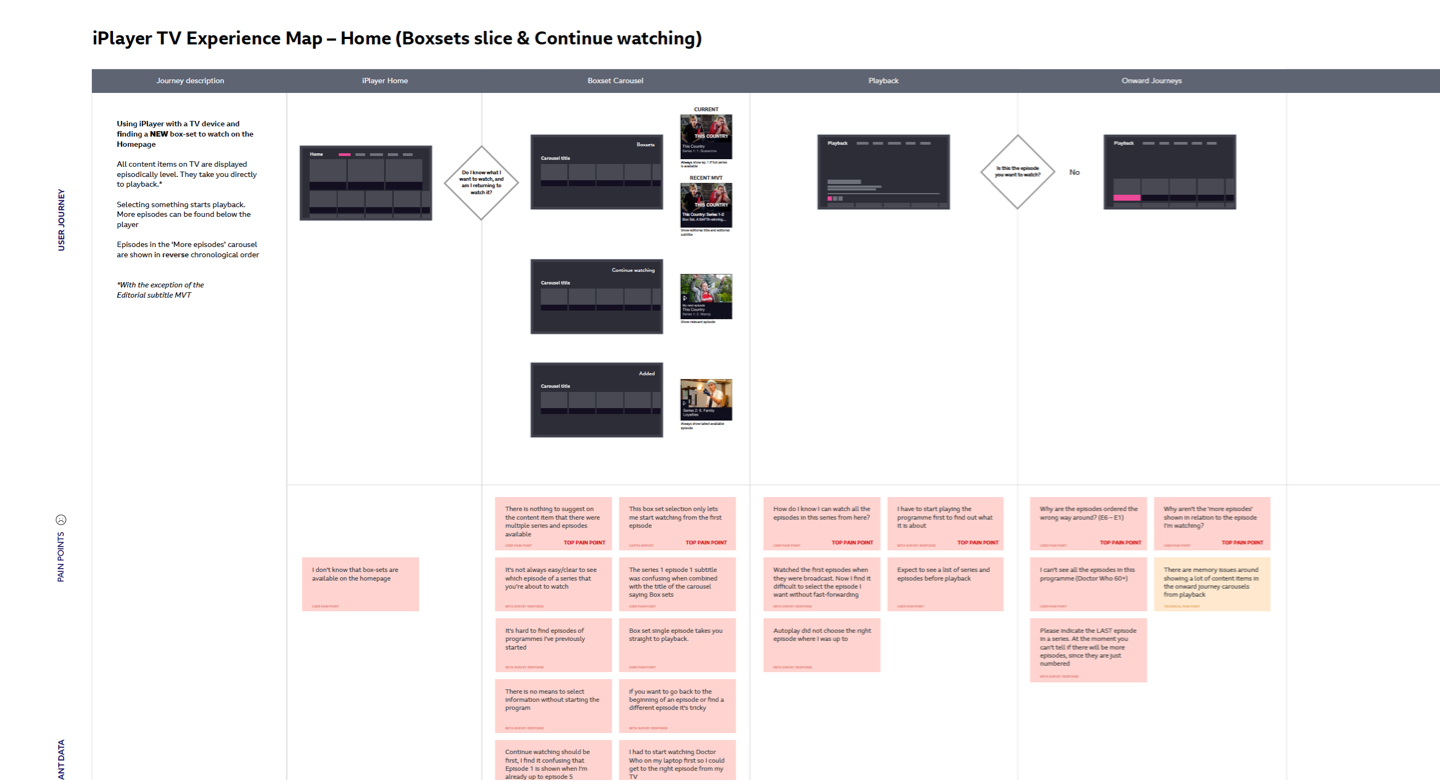Assessing the landscape
First things first, I needed to understand the current journeys to playback in iPlayer. I coordinated an experience mapping session with multiple stakeholders which began to demonstrate that iPlayer was fundamentally designed to promote single episodes, and not a complete series of your favourite program.

The map highlighted where the product was reinforcing a catch up service. But, it also demonstrated where there were opportunities to begin showing the audience full series or box set type content. By running this workshop, it gave everyone a chance to take a look at iPlayer from a different angle. It opened up the possibility of creating something new and changing well established journeys to playback through the product.

I created the experience maps for journeys from the homepage, channels, search and ‘deep-links’ to playback. In each step, I was able to plot issues which iPlayer needed to overcome along the way.
Gathering research about how people watch entire series in iPlayer
With such a wealth of information available to me with many years of user research in iPlayer, I began to revisit this research with a focus on full series. I took an atomic research approach to showing this information. This meant carefully revisiting the outcomes of each user testing session. What the type of audience was? How frequent the feedback was? This helped me start to identify themes.

Atomic research and opportunity maps
The atomic research framework helped enormously with this project because there were many findings from different user research sessions which could be tied together to create overall themes and insights. I worked with the Product team to organise these findings against an opportunity tree model.
These two techniques worked hand in hand with one another. I could follow each opportunity up the tree to the overall goal and objective of the project. I could also follow each opportunity down the tree to a specific finding from a specific testing session. This was indispensable when providing a case or a rationale for what we should be doing to have impact on the product.

Wireframing potential journeys
I now had the confidence to show where iPlayer could begin to change to meet the needs of the audience watching box sets. Next steps were to create wireframes demonstrating this. These wireframes served as a point of reference for product, editorial and developers.
I was able to figure out where the difficulties were with access to data of certain information. This helped change some of the back end systems which had been powering iPlayer for years.

It’s a big task to change a product with it’s foundations in a catch up service to a box set type-of service. With the research and the wireframes in tow – I could begin to put forward a strong proposal for why we should be doing this. Even if it might be costly and expensive to start swapping out some of these foundations.
Understand which features provide most value
Because changing a platform with such a legacy is expensive and time consuming, part of the challenge of this project was being able to balance value and the cost of delivering it. Product teams needed to know more about where they should put their efforts to begin with. This is so they could deliver value as quickly as possible to the audience. To provide this information, I ran kano analysis which helped narrow our sights.

The kano analysis allowed me to suggest which features were must haves and a definite requirement. But also see which features were ‘delighters’ without much positive sustain. This meant I could report back to the product team and project managers with greater detail around which features we should be focussing on first and where we could add value later.
Finalising the designs for build
I now had the full picture of what to do and I could finally begin to craft the experience. I turned the wireframes and low fidelity designs into a polished user interface. Something which needed to feel familiar across multiple platforms. I had to use my experience designing for TVs, mobile apps and the web to deliver a consistent experience that matched the user’s expectations of each platform.

This foundational change to BBC iPlayer was only introduced to flagship series like Doctor who in the very beginning. This was well timed around the Christmas holidays when iPlayer often increases its content offering.
iPlayer is now able to show the audience all the episodes of their favourite programmes and let them to sit back and watch from start to finish. Over time, I expect research to indicate that the perception of iPlayer is beginning to change. As people become familiar with the new status quo.


